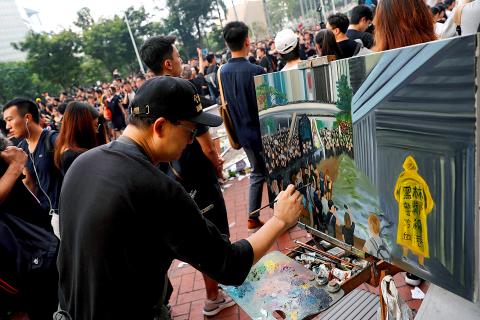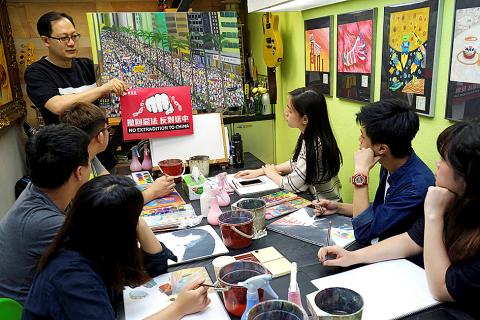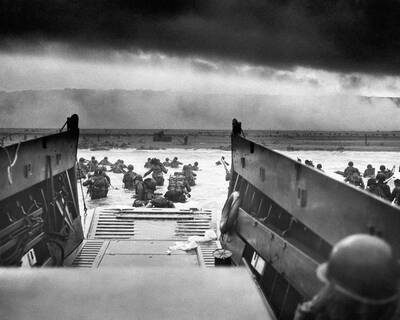For 53-year-old Perry Dino, a paintbrush and canvas are weapons for opposing the Hong Kong government as it faces mass protests against a now-suspended bill that would allow extraditions to mainland China.
Dino, who has painted many of Hong Kong’s social movements, including the pro-democracy “Umbrella movement” in 2014, considers it important to record what is happening in the Chinese-ruled city.
“I am already one of those standing on the front line to defend Hong Kong,” Dino said.

Photo: Reuters
Hong Kong’s government has indefinitely suspended the bill that would allow criminal suspects to be sent to mainland China for trial in courts controlled by the Communist Party.
However, activists — mostly students in face masks, hard-hats and goggles — are demanding the bill be fully withdrawn.
The bill has seen millions of people, fearing erosion of freedoms promised when Hong Kong returned to Chinese rule in 1997, throng the streets in protest, plunging the former British colony into political crisis.

Photo: Reuters
Braving tear gas, rubber bullets and beanbag rounds in recent weeks when protests turned violent, Dino says he has drawn and painted as much as he can about the mass rallies.
“I hope the future generation can understand what Hong Kong has gone through,” he said.
Dino, a part-time teacher, says he hopes that when Hong Kong has true democracy, he can donate his artwork to a “democracy progression museum.”
None of his artwork is currently for sale.
“Making how much money doesn’t matter to me. Only the future matters,” he said.
Among his paintings, which feature colorful brushstrokes, are ones showing demonstrators’ tents occupying major thoroughfares and a flower-etched tribute to a protester who fell to his death.
One painting depicts police firing tear gas, with thick plumes of smoke billowing across a mass of demonstrators. An abstract canvas shows activists shielding their eyes as they flee while a police officer with a rifle grins.
Since he started doing protest artwork in 2012, Dino has joined the annual June 4 Tiananmen Square vigil and made 25 paintings during the “Umbrella movement,” when protesters paralyzed parts of the financial hub for 79 days.
Dino said that during protests, Hong Kong police have told him to paint somewhere else.
In the mainland, Chinese censors strive to erase or block news or depictions of the protests.
Dino is confident he can keep doing what he is doing.
“They can’t hack into my computer and delete it like a photo, nor can they destroy it with a baton as I can always fix my painting,” he said.

Taiwan is one of the world’s greatest per-capita consumers of seafood. Whereas the average human is thought to eat around 20kg of seafood per year, each Taiwanese gets through 27kg to 35kg of ocean delicacies annually, depending on which source you find most credible. Given the ubiquity of dishes like oyster omelet (蚵仔煎) and milkfish soup (虱目魚湯), the higher estimate may well be correct. By global standards, let alone local consumption patterns, I’m not much of a seafood fan. It’s not just a matter of taste, although that’s part of it. What I’ve read about the environmental impact of the

It is jarring how differently Taiwan’s politics is portrayed in the international press compared to the local Chinese-language press. Viewed from abroad, Taiwan is seen as a geopolitical hotspot, or “The Most Dangerous Place on Earth,” as the Economist once blazoned across their cover. Meanwhile, tasked with facing down those existential threats, Taiwan’s leaders are dying their hair pink. These include former president Tsai Ing-wen (蔡英文), Vice President Hsiao Bi-khim (蕭美琴) and Kaohsiung Mayor Chen Chi-mai (陳其邁), among others. They are demonstrating what big fans they are of South Korean K-pop sensations Blackpink ahead of their concerts this weekend in Kaohsiung.

Oct 20 to Oct 26 After a day of fighting, the Japanese Army’s Second Division was resting when a curious delegation of two Scotsmen and 19 Taiwanese approached their camp. It was Oct. 20, 1895, and the troops had reached Taiye Village (太爺庄) in today’s Hunei District (湖內), Kaohsiung, just 10km away from their final target of Tainan. Led by Presbyterian missionaries Thomas Barclay and Duncan Ferguson, the group informed the Japanese that resistance leader Liu Yung-fu (劉永福) had fled to China the previous night, leaving his Black Flag Army fighters behind and the city in chaos. On behalf of the

The captain of the giant Royal Navy battleship called his officers together to give them a first morsel of one of World War II’s most closely guarded secrets: Prepare yourselves, he said, for “an extremely important task.” “Speculations abound,” one of the officers wrote in his diary that day — June 2, 1944. “Some say a second front, some say we are to escort the Soviets, or doing something else around Iceland. No one is allowed ashore.” The secret was D-Day — the June 6, 1944, invasion of Nazi-occupied France with the world’s largest-ever sea, land and air armada. It punctured Adolf